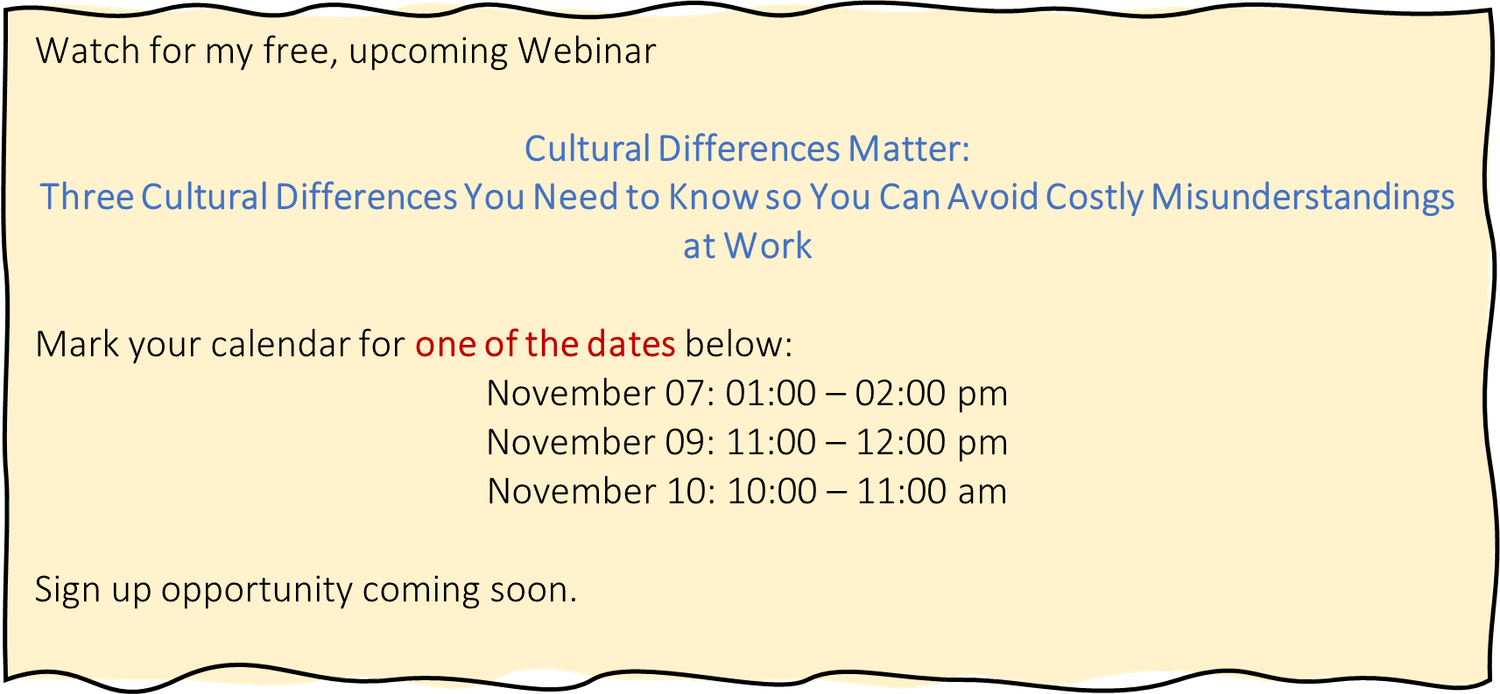Communicating Effectively Across Cultures Series: You Need to Look Beyond the Verbal Messages
"The problem with communication is the illusion that it has been accomplished."
- George Bernard Shaw
When communicating across cultures, you need to remember that there are numerous differences in the ways individuals communicate. In order to avoid any misunderstandings, you need to
learn about differences in conversational and written etiquette, and
avoid projecting your style onto someone else’s.
The following principles are worth mentioning because of their potential for creating misunderstandings in the workplace. They will also raise your awareness of different communication styles.
1. Understand that messages can be
delivered directly or indirectly
The extent to which speakers reveal their intentions through either verbal or written messages will depend on whether they are direct or indirect communicators.
Direct communicators disclose their needs and intentions through spoken and written words. Many individuals in the USA adopt this style as the most appropriate, especially in business contexts.
Indirect communicators, on the other hand, tend to “camouflage” their needs and intentions in their message. For individuals who prefer this style, maintaining harmony in the relationship takes precedence over being totally honest. A “white lie” is more appropriate than telling the truth.
Here is an example. A direct communicator will say “That is not a good idea.”
An indirect communicator, on the other hand, will disagree with the idea by saying “Do you think that is a good idea?” or “Are there any other ideas?”
In increasingly cross-cultural workplaces, it is essential that managers and supervisors remember that different groups place different priorities on telling the truth, being honest, preserving harmony, and trying to avoid conflict.
2. Pay attention to body language, context, and environmental clues
Another significant way in which groups differ in how they communicate relates to their preference for high-context or low-context communication.
For high-context communicators, most of the information is presumed to be understood and, therefore, need not be communicated directly. That is because the speaker’s intention or meaning is already being conveyed through the context (e.g., social roles, status, or positions) and through nonverbal channels (e.g., pauses, silence, tone of voice). The message receiver is the one responsible for “reading between the lines,” and decoding the nonverbal subtleties that accompany the verbal message.
Low-context communicators do just the opposite. For them, most of the information should be transmitted through explicit verbal or written messages. They expect intention or meaning to be delivered explicitly. Straight talk is preferred, and the speaker is the one responsible for constructing a clear, persuasive message that the listener can decode easily.
Below is a list of countries and where they fall in the high/low communication context continuum.
Source: Ting-Toomey and Chung (2012)
Four Key Strategies to Remember When Communicating Across Cultures
Be very careful when interpreting someone’s behavior. That is because we often look at the world through our own culturally tinted lenses. If you find yourself attaching a negative interpretation to someone’s behavior, seek other possible logical explanations. For example, a silent employee could be silent because he is not understanding, he is not interested, he is translating what is being said, he is formulating the proper answer, etc.
Knowledge of culture-specific behavior is useful, but you must keep in mind that it will never apply to all individuals or circumstances. Proper behaviors are those that are appropriate in the context of the culture, setting, and occasion. What is right in one set of circumstances may be totally wrong in another. For example, as someone coming from a high-contact culture, my preferred way to greet individuals is by hugging and kissing them on the cheeks. When meeting US-Americans though, especially in a business setting, I resort to a handshake.
Always put your observational skills to good use and focus on how members of the other culture behave. Things you can pay attention to include:
How far apart do they stand?
What gestures are appropriate?
Do the rules apply to all or only the elderly?
Does the context matter (i.e., business setting only)?
Does it apply to all or only among those with equal status?
While you can expect similarities (i.e., we all need food, shelter, and security), remember that your employees’ cultural upbringing will determine what is appropriate. Culturally competent managers and supervisors understand that and work diligently to build bridges among employees.

Subscribe to The DEI+ Newsletter!
Sign up to get weekly tips and strategies about diversity, equity, and inclusion to help you increase your DEI IQ. Emails are guaranteed short and to the point!

